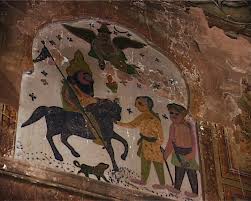Delhi, India:This is a universe marked by a rich tradition of cultural co-existence and exchange, where the boundaries between the apparently monolithic religious identities of ‘Hindu’, ‘Muslim’ and ‘Sikh’ are blurred and subverted in the most imaginative ways
“Close to a million people lost their lives and several million lost
their homelands forever when India and Pakistan were partitioned. In
the midst of the horror that Hindus, Muslims and Sikhs inflicted on
each other there were also redeeming stories of the love that bound
these communities together—stories we cling to, so we may retain our
faith in the human spirit . Milange Babey Ratan De Mele Te is one such
story. It is the story of how love survived a holocaust.”
Arundhati Roy
Borders spring up from nowhere; new nations are born of a violent rupture and unprecedented blood-letting, uprooting millions of people; and, a centuries-old composite culture is silenced forever. Or so it would seem… On the eve of the British leaving the subcontinent in 1947, Punjab was partitioned along religious lines. Thus was created a Muslim majority state of Punjab (west) in Pakistan and a Hindu /Sikh majority state of Punjab (east) in India. For the people of Punjab, it created a paradoxical situation they had never experienced before: the self became the Other. The universe of a shared way of life – Punjabiyat — was marginalised. It was replaced by perceptions of contending identities through the two nation states.
For most of us this has been the narrative of Punjab– once known as the land of five waters, now a cultural region spanning the border between Pakistan and India. However, the idea of Punjabiyat has not been totally erased. In ways seen and unseen, it continues to inhabit the universe of the average Punjabi’s everyday life, language, culture, memories and consciousness. This is the universe that the film stumbles upon in the countryside of east Punjab, in India. Following the patters of lived life, it moves fluidly and eclectically across time, mapping organic cultural continuities at the local levels.
Accompanying this caravan of seekers and lovers are the ascetic non believers in whom a yearning for love and harmony turns into poetry against war and aggression
It is a universe which reaffirms the fact that cultures cannot be erased so very easily. This is a universe marked by a rich tradition of cultural co-existence and exchange, where the boundaries between the apparently monolithic religious identities of ‘Hindu’, ‘Muslim’ and ‘Sikh’ are blurred and subverted in the most imaginative ways. Moreover, one finds in this universe, mythologies from the past sanctifying such transgressions and reproducing themselves in the present; iconographies of Hindu gods and Sikh gurus share space with lovers, singers and wrestlers, creating a rich convergence of the sacred, the profane, and the subversive.
Nothing represents this more than the Qissa Heer, a love balled exemplifying a unique Punjabi spirituality identified with love, whose multiple manifestations richly texture this landscape.
Source:Hardnews Bureau
 Sikh Sangat News Celebrating Sikh culture and sharing Sikh voices
Sikh Sangat News Celebrating Sikh culture and sharing Sikh voices

